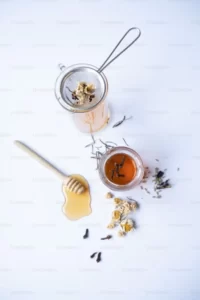Table of Contents
Introduction
When it comes to Mānuka Honey, there are two main types to consider: monofloral and multifloral. Each has its own unique characteristics and benefits. In this article, we will explore the differences between monofloral and multifloral Mānuka Honey, and help you decide which one is best for your needs.
Monofloral Mānuka Honey
Monofloral Mānuka Honey is made from the nectar of the Mānuka flower only. This means that the bees that produce this honey primarily forage on Mānuka flowers, resulting in a honey that is rich in Mānuka’s unique properties.
Authenticity and Quality Verification
To ensure the authenticity and quality of monofloral Mānuka Honey, it is important to look for the Unique Manuka Factor (UMF) quality trademark. This certification guarantees that the honey has been independently tested in a laboratory for authenticity, freshness, purity, and potency.
MGO Levels
One of the key factors to consider when choosing monofloral Mānuka Honey is its Methylglyoxal (MGO) level. MGO is the compound responsible for Mānuka Honey’s antibacterial properties. The higher the MGO level, the more potent the honey is.
Monofloral Mānuka Honey typically has higher MGO levels compared to multifloral honey. This makes it an excellent choice for those seeking the maximum health benefits of Mānuka Honey.
Usage Recommendations
Due to its higher potency, monofloral Mānuka Honey is often consumed straight from the spoon or used as a natural sweetener. It can also be added to teas, tonics, or elixirs to enhance their health benefits. Additionally, monofloral Mānuka Honey can be used as a topical treatment for various skincare applications.
Multifloral Mānuka Honey
Multifloral Mānuka Honey is made from a combination of Mānuka flower nectar and other wildflower nectars. This blend creates a creamy and indulgent honey with a unique flavor profile.
Authenticity and Quality Verification
Just like monofloral Mānuka Honey, it is important to choose multifloral honey that carries the UMF quality trademark. This ensures that the honey has been tested and verified by an approved laboratory for its authenticity and quality.
MGO Levels
Multifloral Mānuka Honey generally has lower MGO levels compared to monofloral honey. However, it still retains some of the beneficial properties of Mānuka Honey, making it a popular choice for everyday wellbeing.
Usage Recommendations
Multifloral Mānuka Honey is versatile and can be used in both sweet and savory culinary dishes. It can be drizzled over breakfast cereals or smoothies, used as a natural sweetener in cooking, or added to hot beverages for an indulgent twist.
Choosing the Right Mānuka Honey for You
When deciding between monofloral and multifloral Mānuka Honey, it ultimately comes down to personal preference and the specific benefits you are seeking.
If you are looking for maximum potency and the highest levels of MGO, monofloral Mānuka Honey is the way to go. It is ideal for those who want to experience the full health benefits of Mānuka Honey and are willing to invest in a higher-grade product.
On the other hand, if you prefer a milder flavor and want to incorporate Mānuka Honey into your everyday diet, multifloral honey is a great choice. It still offers some of the beneficial properties of Mānuka Honey and can be enjoyed in a variety of culinary applications.
Conclusion
Both monofloral and multifloral Mānuka Honey have their own unique qualities and benefits. The key is to choose a honey that suits your preferences and meets your specific needs. Whether you opt for the potent and high-grade monofloral honey or the versatile and everyday multifloral honey, you can rest assured that you are getting 100% pure and authentic Mānuka Honey when you choose a UMF-certified product.
So, take your time to explore the different options available and find the Mānuka Honey that will best complement your wellness routine. Enjoy the rich flavors and health benefits that this extraordinary honey has to offer.



